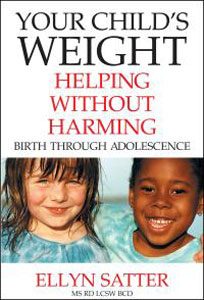

Family Meals Focus
The Ellyn Satter Institute Newsletter
Are We Teaching Our Children Conflict and Anxiety About Food?
by Jennifer Harris, RDN, LD, CEDRD-S
For a PDF of this issue of Family Meals Focus, click here
Provide, don’t deprive, and trust your child to eat well and grow up to have the body she is meant to have. Your child is entitled to be free from worry about eating, moving, and weight. You are entitled to feel comfortable about doing your feeding jobs and relaxed about trusting your child to do their eating jobs. You do not have to get caught up in the weight and health hysteria that frightens your child about their eating and weight and undermines you in doing a good job of parenting with food.
First, a disclaimer: In my view, the words “obesity” and “overweight” come loaded with stigma. It is that loading and interpretation I intend in this article.
Consider these scenarios:
- My niece asked her mother if she could have a piece of bread pointing out that she had eaten all her fruits and vegetables. She is not allowed to eat bread unless she eats all her other foods.
- A fellow parent shared her concern about her daughter’s intake of desserts and said she had instructed her daughter to exercise more to compensate. I cautioned her about the potential for harmful messaging to her daughter, such as: “you are gaining too much weight,” or “desserts will make you fat.” The mother didn’t set out to intentionally hurt her daughter, but her child still knew her mother was concerned about her weight.
- Not long ago my college aged daughter sent me a panicked text. “Is cheese bad for me?” A well-intentioned friend, a student in a health care discipline, noted my daughter’s love for cheese and told her it was bad for her. I never taught my daughter about cheese; I just fed it to her. This one comment undermined her confidence with eating.
How things used to be
When I tell these stories to my own mother, she looks bewildered and says she never had these types of concerns when feeding her family. She served the meal, we showed up hungry, we ate what we wanted from the offerings placed before us, and we asked to be excused — usually eager to get back to our friends for more play time. My mother certainly didn’t worry about whether I was getting the right number of minutes of physical activity a day, and there was no discussion about calories or “balancing the energy equation.”
It’s different now
Children are worried.1,2 Parents are confused. And within this fright and confusion lies the irony of obesity “treatment:” Despite current health initiatives to address overweight in ourselves and our children, we are getting heavier. So we must ask the question: Are we treating the cause? Or are we causing what we are trying to treat? And are we tempting disorder in the process?
Pediatric and adult obesity3 rates are increasing and for adolescents eating disorders are on the rise as well. In fact, the median age of onset may be as low as 12-13 years.4 A study involving girls ages 3-6 reported that half worried about being fat and a third reported they would change their appearance. This is despite the fact that nearly all reported that they liked how they looked.7 It’s easy to blame technology, safety, busy families and more food choices. Instead, we need to think about our reaction to weight and childhood obesity. In our fight against obesity, have we sent the wrong messages to children?
- Emphasized weight rather than health?5,6
- Fed our children for disease prevention instead of normal growth and development?
Parenting with food: more doing; less talking
How do you talk to your kids about food, health, exercise, and weight? Prior to late adolescence it isn’t about talking at all, it’s about doing. Parenting includes many, many things, including parenting around food. Maintaining the Satter Division of Responsibility in Feeding (sDOR) demands commitment, consistency and trust. Stick with it and your child will grow up to feel good about food and eating, have the body s/he was meant to have, have a more stable adult body weight, eat a more varied diet, and experience improved health. The fruition of proper childhood feeding results in all those things, and it even has a name: Eating Competence, as in the Satter Eating Competence Model. How can you support eating competence in your child? Feed well and expose your child to movement in a manner that is enjoyable and sustainable.
Parent in the best way around food
- Maintain sDOR. As far as meals and snacks are concerned: Parents are responsible for: what, when and where.
- Children are responsible for: how much and whether.
- Maintain structure and routine with meals and snacks. Set times and places to eat. Even on weekends. It means planning ahead for you, but it’s worth it. It means no food or beverages between meal and snack times (except water). Children are more curious and willing to try new foods when they come to the table hungry. When they know they will be fed and will be allowed to get enough to eat, they do well intrinsically regulating their intake
- Keep food neutral and avoid restraint. Children who do not get enough to eat, who do not get to eat the foods they like, or who are encouraged to follow food rules tend to overeat if given the opportunity. They are at risk of having higher body weight as a result.8 Restraint can look like: not having enough food, never offering desserts or high fat foods, or encouraging “eat this, before that” strategies.Restraint can also be about food insecurity: not having enough money to buy food or meals being so erratic that children can’t count on being fed. By avoiding the pressures placed on adults to feed the “right foods”, or the “right amounts” will allow them to focus on predictability and reassurance for the child. Internal regulation and food variety will follow once routine is established. The Satter Hierarchy of Food Needs
- Within the structure of sDOR, balance family-food offerings with foods they readily accept and foods that are new to them and include “forbidden foods.” In this way, children are provided with repeated neutral exposure to foods, complementing children’s natural curiosity as it relates to food. As a result, children eat as much as they want and need, and outside of typical taste and texture preferences they learn to eat the foods their parents offer and eat themselves. Children who are raised with sDOR grow up knowing how to take care of themselves with food. 9
Parent in the best way around activity
- Maintain a division of responsibility with activity.
- Parents are responsible for: structure, safety, and opportunities for movement
- Children are responsible for: how much and whether.
- Set limits on screen time but not reading, writing or other sedentary activities.
- Tolerate a normal level of commotion in the home.
The take-home message
Provide, don’t deprive, and trust your child to grow and develop into the body they are meant to have. They will be healthy.
References
Explore
For help protecting themselves against interference and raising your child who loves her body and is joyful about eating, Your Child’s Weight: Helping Without Harming .
Related issues of Family Meals Focus
- Feeding is parenting
- Feeding pressure on all sides
- Feeding your adolescent: Problem-solving
- How to feed your child: birth through adolescence
- Moves and counter-moves with feeding your child
- Trouble-shooting with the division of responsibility

